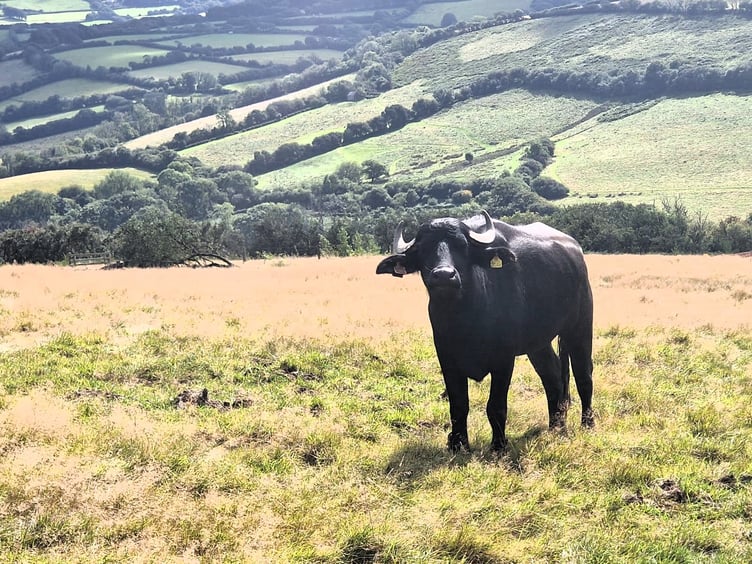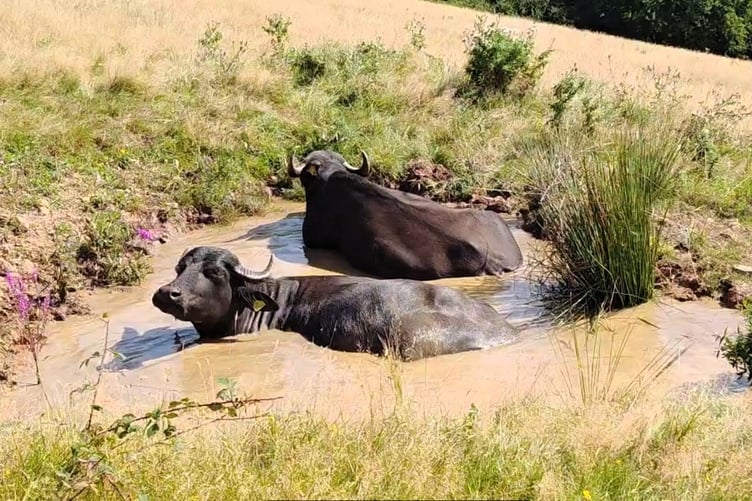A HERD of water buffalo more likely to be found in South East Asia swamps and forests have taken up residence on a National Trust site on Exmoor in a bid to restore biodiversity and reshape the landscape.
The buffalo have been introduced onto the 120-acre site at Tattiscombe to play a major role in a new phase of Exmoor conservation.
Known as ‘wetland architects’, the buffalo use their hooves to churn soil, create wallows, and keep pools open - slowing water flow and helping it settle naturally.
Their browsing behaviour clears scrub, making space for wildflowers and other species to thrive, which in turn supports insects, birds, and mammals.
Murray Sharpe, farm manager for the West Exmoor National Trust, said: “Buffalo are specialised wetland animals, and this site offers an ideal habitat for them.

“They are hardy, disease-resistant and able to thrive on rough forage.
“Their thick skin and natural wallowing habits make them more tolerant of flies and ticks than cattle, which means they are well-suited to this landscape.
“By grazing and browsing around the many ponds and ditches on site, they will help shape a broader range of habitats than we could achieve without them.
“In doing so, they will create a wealth of new niches for wildlife and play a role in driving the ecology of the site.”
The buffalo arrival builds on the success of the National Trust’s Riverlands project on its Holnicote estate which restored lost wetland by diverting a stream back into its natural floodplain.
This work helps the site hold water during floods and droughts, boosts biodiversity, and improves the landscape’s resilience.
The project is funded by the Government’s Species Survival Fund, developed by Defra and delivered by The National Lottery Heritage Fund in partnership with Natural England and the Environment Agency.
Tattiscombe project manager Alex Palmer said: “Introducing buffalo here will build on the success of the work already completed on site, adding a natural way to keep ponds open, spread wetland plants, and create new niches for insects and birds.
“The buffalo are a key component to the future success for this site and we are looking forward to seeing their impact.”
Alongside the buffalo, Mangalitsa pigs are also helping to shape the landscape.
Their rooting behaviour creates bare ground that supports wildflowers and insects, while slowing surface water, and disturbed patches can be over-sown with wildflower seed.
Other interventions carried out by rangers and volunteers include removing underground land drains, filling in old ditches to allow water to spread more widely, and creating wildlife habitat piles from hedgerow cuttings.
Exmoor area ranger Jack Ward said: “Our incredible volunteers have been at the heart of everything, from carrying out wildlife surveys to removing miles of fencing.
“Their energy and dedication have really brought this site to life.”
As the buffalo settle into their new home, the team will continue monitoring how the landscape responds, tracking changes in water flow, plant diversity, and wildlife numbers over the coming years.




Comments
This article has no comments yet. Be the first to leave a comment.